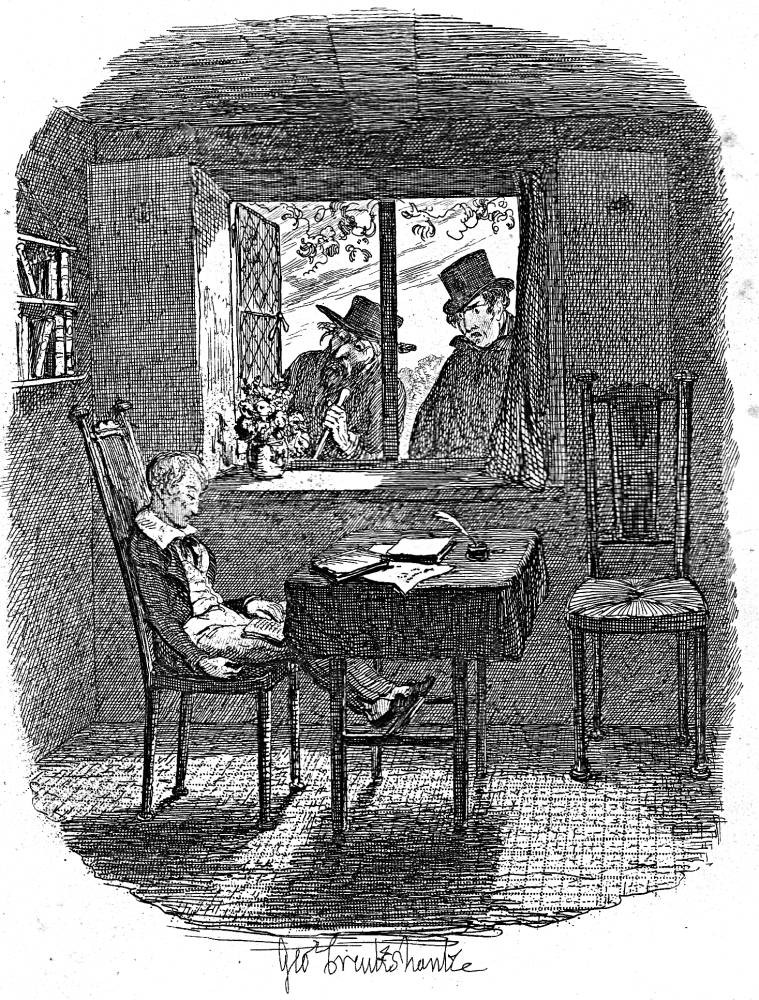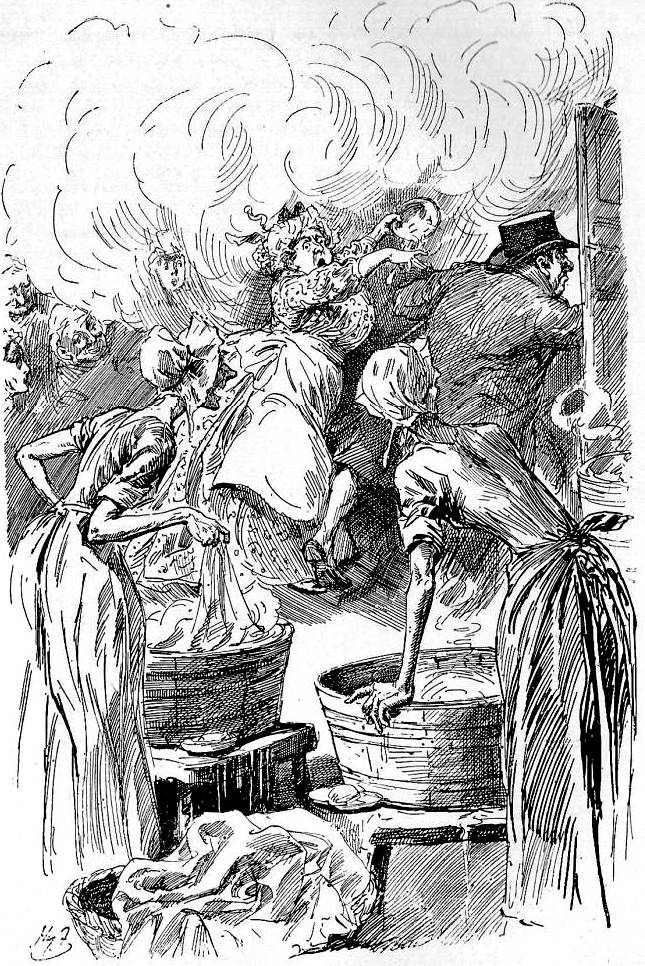
"Fagin!" whispered a voice close to his ear. — James Mahoney's fourteenth illustration, revealing to readers of the Household Edition the conspiracy between Oliver's half-brother, Edward Leeford (alias, "Monks"), and Fagin to prevent Oliver's realizing his identity and claiming his inheritance. How long this conspiracy has been going forward the reader can only speculate as Dickens has just introduced the name "Monks" in the dialogue between Fagin and the landlord of The Three Cripples:
"Will he be here to-night?" asked the Jew, laying the same emphasis on the pronoun as before.
Monks, do you mean?" inquired the land-lord, hesitating.
Hush!" said the Jew. "Yes."
Certain," replied the man, drawing a gold watch from his fob; "I expected him here before now. If you'll wait ten minutes, he'll be —" [Chapter 26, "In Which a Mysterious Character Appears Upon the Scene; and Many Things, Inseparable from This History, are Done and Performed," page 93]
Although Mahoney has introduced this shadowy figure in a black cape in the Frontispiece, ironically, Dickens reveals Monks' role in the story only after the object of his antipathy has once again slipped the custody of Sikes, who has deposited the wounded boy in a ditch near Chertsey, believing the boy to be dying. In the original narrative-pictorial serial sequence by George Cruikshank in Bentley's Miscellany, the periodical reader did not encounter a pictorial realization of Monks until the June 1838 instalment, whereas Dickens introduces this clandestine meeting between Fagin and Monks (designated "A Mysterious Character," 91) in Chapter 26, which originally was situated in Part Twelve (March 1838), at the mid-point of serialisation, but was accompanied by the humorous illustration Mr. Claypole as he appeared when his master was out at the north of England town where Oliver began his journey. The Field Lane scene by Mahoney, a species of "dark plate", occurs as an adjunct to what was originally the middle-most monthly instalment of Dickens's The Adventures of Oliver Twist, a placement suggesting that Dickens felt that he had exhausted the possibilities for critiquing the institution of the workhouse, and was casting about for some fresh means of sustaining reader interest — and monthly sales of Bentley's. This visual reintroduction of Monks in the Household Edition occurs on page 89. 1871. Wood engraving by the Dalziels, 9.3 cm high by 13.6 cm wide. Scanned image and text by Philip V. Allingham. [You may use this image without prior permission for any scholarly or educational purpose as long as you (1) credit the person who scanned the image and (2) link your document to this URL in a web document or cite it in a print one.]
Passage Illustrated
The sharp wind that scoured the streets, seemed to have cleared them of passengers, as of dust and mud, for few people were abroad, and they were to all appearance hastening fast home. It blew from the right quarter for the Jew, however, and straight before it he went: trembling, and shivering, as every fresh gust drove him rudely on his way
He had reached the corner of his own street, and was already fumbling in his pocket for the door-key, when a dark figure emerged from a projecting entrance which lay in deep shadow, and, crossing the road, glided up to him unperceived.
"Fagin!" whispered a voice close to his ear
"Ah!" said the Jew, turning quickly round, 'is that —
"Yes!" interrupted the stranger. "I have been lingering here these two hours. Where the devil have you been?"
"On your business, my dear,' replied the Jew, glancing uneasily at his companion, and slackening his pace as he spoke. 'On your business all night."
"Oh, of course!" said the stranger, with a sneer. "Well; and what's come of it?"
"Nothing good," said the Jew.
[Chapter 26, "In Which a Mysterious Character Appears Upon the Scene; and Many Things, Inseparable from This History, are Done and Performed," page 95]
Commentary: "Monks," The Mysterious Gentleman
The viewer's first reaction to this scene is, "What is a well-dressed gentleman doing, consorting with the disreputable figure of Fagin in such a slum area at such a time of night?" And, indeed, the arrival of the cloaked figure and shadowed visage of "Monks" (the alias of Edward Leeford, Oliver's half-brother) transforms the narrative from a Newgate Novel and a Hogarthian progress to a tale of a lost heir, the burglary in Chertsey having already morphed the story of the parish boy into a tale of crime and detection. (It is possible to argue that the novel from first to last is a mystery, but the term "bildungsroman" does not fit simply because Dickens does not follow Oliver in adulthood.)
Now the narrative begins to reveal Fagin's true motives in training the boy to become a thief, for Oliver will either vanish from middle-class eyes into the murky criminal underworld of London, or be incarcerated, or transported — or executed as a felon, and therefore never realise that he is the legitimate heir of Edwin Leeford. This shadowy figure of the evil, plotting half-brother who covets Oliver's portion of the patrimony — a Cain to Oliver's Abel — is the subject of Sol Eytinge, Junior's character study Monks in the 1867 Diamond Edition of the novel. Whereas Mahoney, like Eytinge, was well aware of Monks's importance to the "missing heir" plot, Cruikshank introduces Monks later, in company with Fagin at Oliver's window in the garden at Chertsey. Eytinge shows the melodramatic villain by himself, alienated, brooding, and malevolent, the child of privilege who considers nobody's welfare but his own. The cape in which the various illustrators clothe him is the outward and visible sign of his attempt to act in secret, so that he acts with his criminal associates under an assumed identity. His manner and speech, however, betray his true background. His association with Fagin in Cruikshank's and Mahoney's illustrations shows that he is prepared to violate the barriers of class and propriety in order to advance his fortunes, evenat the cost of Oliver's life. Cruikshank, Eytinge, and Mahoney depict the venomous older brother as "a tall man wrapped in a cloak" (Ch. 34, 121; "his face averted," 127), his height consistently exaggerated by his respectable top-hat. Tellingly, Fagin apparently fears even uttering his name.
The August 1838 George Cruikshank illustration surely is the basis for the later interpretations of Mahoney, Furniss, and Eytinge for the scene in which, conspiring with the Bumbles, Monks destroys the evidence of Oliver's true, upper-middle-class origins. Mahoney's interpretation of Monks' clandestine meeting with Fagin at Saffron Hill past eleven o'clock at night accords well with the gothic figure's surreptitious nature, similarly presented in Mahoney's Household Edition frontispiece. From the outset in the Household Edition, Monks is a significant figure in the plot — but then, Mahoney, having read the entire book before receiving the Chapman and Hall commission, would have known the entire story, whereas Cruikshank knew only as much as he had read in the monthly instalments up to that point and as much as Dickens himself was prepared to reveal.
That Harry Furniss gave the black-cloaked figure of Monks holding the lantern a place of prominence (the lower left-hand corner) in Characters in the Story, the ornamental border for the title-page of the 1910 volume, suggests that the later artist felt this was a pivotal moment in the narrative, even if he felt it necessary to depict Monks with his signature hat on in both the vignette and the full-page lithograph, which we encounter immediately after Dickens's economical but telling description in the text. Furniss, guided by the author's and original illustrator's choice of scenes for the monthly engravings, introduces Monks in a scene precisely paralleling Cruikshank's in Chapter 34, Monks and the Jew (June 1838) with Monks and Fagin watching Oliver sleep, the significant changes being designating Fagin by name (rather than as "The Jew") in the caption, and placing the emphasis on the figure of Oliver, dozing over his book's on a summer evening.
Illustrations from the initial serial edition (1837-39), Diamond Edition (1871), and Charles Dickens Library Edition (1910)



Left: George Cruikshank's Monks and the Jew. Centre: Sol Eytinge, Junior's Monks . Right: Harry Furniss's Monks and Fagin watching Oliver sleep. (1910). [Click on images to enlarge them.]
References
Bentley, Nicolas, Michael Slater, and Nina Burgis. The Dickens Index. New York and Oxford: Oxford U. P., 1990.
Darley, Felix Octavius Carr. Character Sketches from Dickens. Philadelphia: Porter and Coates, 1888.
Davis, Paul. Charles Dickens A to Z: The Essential Reference to His Life and Work. New York: Facts On File, 1998.
Dickens, Charles. Oliver Twist. Illustrated by George Cruikshank. London: Bradbury and Evans; Chapman and Hall, 1846.
Dickens, Charles. Oliver Twist. Works of Charles Dickens. Household Edition. 55 vols. Il. F. O. C. Darley and John Gilbert. New York: Sheldon and Co., 1865.
Dickens, Charles. Oliver Twist. Works of Charles Dickens. Diamond Edition. 18 vols. Illustrated by Sol Eytinge, Jr. Boston: Ticknor and Fields, 1867.
Dickens, Charles. The Adventures of Oliver Twist. Works of Charles Dickens. Household Edition. Illustrated by James Mahoney. London: Chapman and Hall, 1871.
Dickens, Charles. Oliver Twist. Works of Charles Dickens. Charles Dickens Library Edition. Illustrated by Harry Furniss. London: Educational Book Company, 1910.
Last modified 8 December 2014